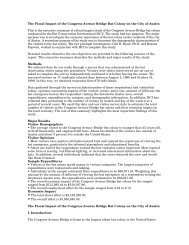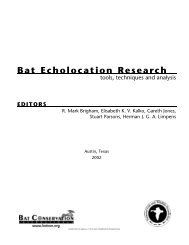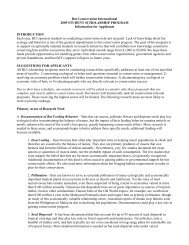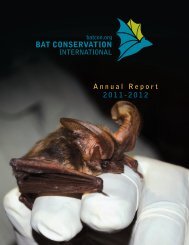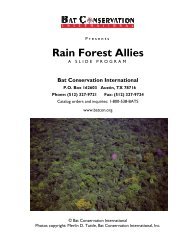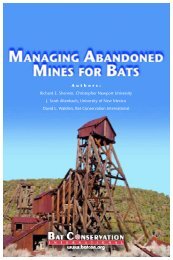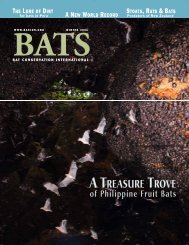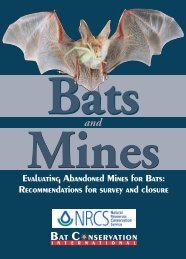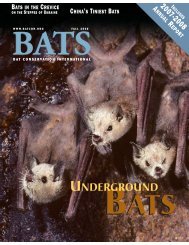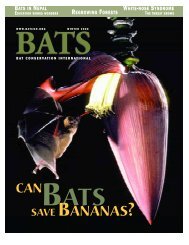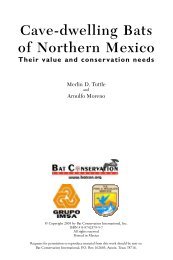Bat Conservation and Management Workshop
Bat Conservation and Management Workshop
Bat Conservation and Management Workshop
Create successful ePaper yourself
Turn your PDF publications into a flip-book with our unique Google optimized e-Paper software.
BCI <strong>Bat</strong> <strong>Conservation</strong> <strong>and</strong> <strong>Management</strong> <strong>Workshop</strong> – Arizona<br />
cover was 100% in most areas, <strong>and</strong> branches of alders<br />
interdigitated, creating the appearance of a tunnel of<br />
air space over the stream.<br />
I monitored activity of bats for 94 nights at Bark<br />
Creek <strong>and</strong> for 101 nights at Buttermilk Creek between<br />
29 June 1993 <strong>and</strong> 12 October 1994 using the Anabat<br />
II bat detector system according to methods described<br />
by Hayes <strong>and</strong> Hounihan (1994). Echolocation calls<br />
were recorded on audio tape as bats flew over or near<br />
a monitoring station. I defined each sequence of one<br />
or more echolocation pulses with < 1 s between<br />
sequential pulses as a pass by a bat (Fenton, 1970).<br />
Calls were recorded along with the time of day <strong>and</strong> a<br />
calibration tone to aid in later analysis. <strong>Bat</strong> detectors<br />
were set at a sensitivity of six to minimize stream <strong>and</strong><br />
insect noises <strong>and</strong> to eliminate detections of bats flying<br />
in adjacent habitats. Each monitoring station was<br />
within 3 m of the edge of the stream with the<br />
microphone of the bat detector facing parallel to the<br />
main axis of the stream.<br />
I sampled populations of insects for 89 nights at Bark<br />
Creek <strong>and</strong> for 87 nights at Buttermilk Creek between<br />
June 1993 <strong>and</strong> October 1994 using 10-watt black light<br />
traps (Bioquip, Santa Monica, CA) powered by 12-<br />
volt gel cells. Traps were set to operate for a 3-h<br />
period beginning 30 min after legal sunset using a 12-<br />
volt timer (Real Goods, Ukiah, CA). Insects were<br />
collected in alcohol, oven-dried $ 24 h, <strong>and</strong> weighed.<br />
Preservation of invertebrates in alcohol decreases their<br />
dry weight biomass (Leuven et al., 1985), <strong>and</strong>, thus,<br />
estimates of dry mass may be biased <strong>and</strong> only should<br />
be considered as indices. I monitored minimum<br />
nightly temperatures at the bat-monitoring stations<br />
using Hobo-Temp monitors (Onset Instruments,<br />
Pocasset, MA).<br />
Analysis of activity levels <strong>and</strong> environmental<br />
correlates. An analysis of 1,879 passes recorded<br />
during 10 r<strong>and</strong>omly selected nights at Bark Creek <strong>and</strong><br />
at Buttermilk Creek revealed that > 99% of<br />
identifiable calls had characteristics typical of species<br />
of Myotis (Hayes <strong>and</strong> Adam, 1996). Because of<br />
similarities in characteristics of echolocation calls<br />
among species of Myotis in this geographical area, I<br />
did not attempt to categorize calls to species in this<br />
study.<br />
I used an index of activity (IA) as a measure of<br />
activity levels. For nights when bats were successfully<br />
recorded throughout the night, IA is the total number<br />
of passes recorded. During nights with highest levels<br />
of activity, audio tapes were filled with calls of bats before<br />
the end of the night. To determine the IA for these nights,<br />
I assumed that the best estimate of total activity was a<br />
function of the number of passes recorded, the proportion<br />
of the night elapsed when the tape was filled, <strong>and</strong> the<br />
proportion of the total number of passes expected to occur<br />
during that portion of the night. This approach is not ideal,<br />
as patterns of activity can vary among nights. However,<br />
this approach should provide a general index of activity<br />
that is acceptable for use of rank-order statistical<br />
procedures. To determine patterns of activity within nights<br />
for use in calculating IA <strong>and</strong> for assessment of temporal<br />
pattern, I determined each night at Bark Creek for which<br />
audio tape were not completely filled with calls before the<br />
end of the night <strong>and</strong> for which at least 175 passes were<br />
recorded (n = 24 nights). I restricted the analysis to these<br />
night because I assumed that the pattern of activity in<br />
these nights with relatively high levels of activity ($ 175<br />
calls) would most closely reflect the pattern of activity on<br />
nights for which the tapes were filled with calls prior to<br />
the end of the night. To account for differences in length<br />
of night, activity was partitioned into 20 equal-time<br />
intervals from sunset to sunrise these intervals varied from<br />
26 to 41 min (0 = 29.7 min). The proportion of passes<br />
recorded in each interval was determined <strong>and</strong> the mean<br />
proportion for all these nights was calculated. For nights<br />
when the tape was filled with calls of bats before the end<br />
of the night, the IA was calculated by dividing the number<br />
of passes recorded by the mean proportion of passes<br />
recorded in that proportion of the night.<br />
I tested for correlations between nightly IA at Bark <strong>and</strong><br />
Buttermilk creeks, <strong>and</strong> between IA at each site <strong>and</strong> length<br />
of night, hours of moonlight, phase of moon (expressed as<br />
a percentage of full moon), dry mass of insects captured at<br />
the site, <strong>and</strong> minimum nightly temperature at the site using<br />
Spearman‘s p. I also examined correlations between dry<br />
mass of insects <strong>and</strong> minimum nightly temperature. I<br />
determined statistical power of tests that resulted in nonsignificant<br />
results using tables in Kraemer <strong>and</strong> Thiemann<br />
(1987). Because of significant correlations among<br />
variables, I examined partial correlations of activity of<br />
bats with dry mass of insects <strong>and</strong> with minimum nightly<br />
temperature.<br />
Effect of number of nights sampled. As activity of bats<br />
generally is greatest <strong>and</strong> most sampling typically occurs<br />
during the summer months, I examined data from June,<br />
July, <strong>and</strong> August at Bark Creek (1993, n = 24 nights;<br />
1994, n = 22) <strong>and</strong> Buttermilk Creek (1993, n = 28; 1994, n<br />
= 18) to determine the influence of number of nights<br />
sampled on estimates of activity of bats. I r<strong>and</strong>omly<br />
© 2011 – <strong>Bat</strong> <strong>Conservation</strong> International Page 159



